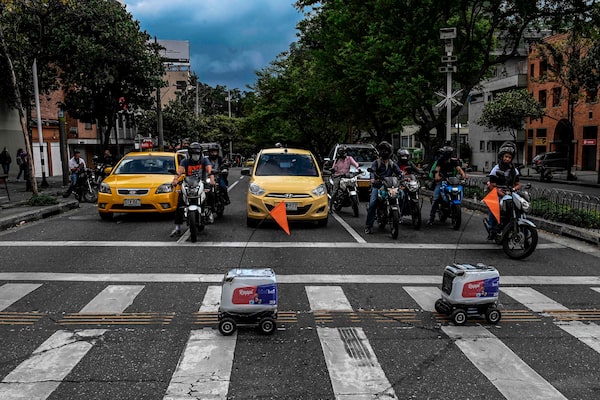
An Amazon robot sends a package down a chute at a warehouse facility in Goodyear, Ariz., on Dec. 17, 2019.Ross D. Franklin/The Associated Press
We’re a long way from a self-driving car in every driveway, but an autonomous future might be closer than most of us think – and we might be bringing it even closer every time we buy something online and want it tomorrow.
"I don't see a lot of people lining up with piles of cash demanding self-driving vehicles," says Anthony Townsend, an AV consultant and author of Ghost Road: Beyond the Driverless Car. "But there's huge demand for delivering more stuff to our homes."
While there have been predictions that we're decades away from fully autonomous vehicles (AVs) that can drive anywhere without human supervision, Townsend thinks we'll see simpler AVs a lot sooner.
"We're seeing [AV technology] show up in scooters, delivery vehicles, drones, buses and wheelchairs," Townsend says. "I think the driverless car is a big part of the story, but we'll see all these other ways of getting around that are suited to these more specialized mobility needs."
With more people shopping online during the COVID-19 pandemic, Amazon drivers say their workloads have become overwhelming. In a few months, “we’ve seen a five-year leap in how much stuff we’re buying,” Townsend says.
Those deliveries are costing the company money, he says.
"Amazon is basically subsidizing [delivery] right now, the same way Uber and Lyft were subsidizing ride-sharing," Townsend says. "They spend US$3-4 on every parcel."
Automation could make that cheaper, and there are signs Amazon might be moving in that direction, Townsend says. The company already uses robot vehicles in its warehouses. Last month, Amazon bought Zoox, an AV ride-hailing startup, for a reported US$1.2-billion.

Zoox CEO Aicha Evans delivers a keynote speech at the Amazon Re:MARS conference in Las Vegas, on June 6, 2019.MARK RALSTON/AFP/Getty Images
"They said they're planning to get into the ride-hailing business, but it may be because they're planning in extending the automated vehicles in their warehouses onto the street," Townsend says.
Parcels, not people?
According to a recent survey, we’re not ready to ride in self-driving cars, but we’re not as put off by the idea of them carrying our packages.
In a survey of 1,000 people in the U.S. by Myplanet, a Toronto-based AI company, nearly 85 per cent said they were uncomfortable with the idea of fully autonomous vehicles. But 37 per cent said they were comfortable with robot food delivery.
"There are related uses for autonomous transport, such as food and package delivery, which we are quite ready for as a society," said Jason Cottrell, Myplanet CEO, in an e-mail. "Neither requires us to be passengers."

A Postmate delivery robot moves along a Los Angeles sidewalk on March 24, 2020.CHRIS DELMAS/AFP/Getty Images
But won't these robot delivery vehicles be on the same roads as the rest of us?
"It's a much more restricted universe," Townsend says. "An AV has to operate on any road in North America, where the delivery vehicle only has to operate on a specific route at the time a company tells it to."
That could mean robo-vans on our streets in the next few years. They may be on the sidewalks even sooner; Amazon has tested cooler-sized delivery robots in California and Washington.
Trojan horse?
Once we're comfortable with the idea of robots carrying our stuff, Townsend thinks AVs carrying people, first as buses and taxis, will be next.
“I think people will get exposed to AVs outside the realm of the automotive industry,” Townsend says. “What will be really critical is building up a cultural familiarity with good experiences rather than bad ones.”

Two delivery robots cross a street in Medellin, Colombia, on April 22, 2020.JOAQUIN SARMIENTO/AFP/Getty Images
We'll also need to get over the perception that AVs are unsafe, Townsend says.
“There’s a tremendous amount of attention on the crashes,” he says. “But it’s actually pretty well-understood that people are much harsher judges of computers. In reality, these products are much safer than human drivers.”
KPMG’s 2020 Autonomous Vehicle Readiness Index, released this month, predicts that COVID-19 – and the need for physical distancing and contactless delivery – will accelerate AV research, and Townsend agrees.
Even if a vaccine is found, Townsend predicts that more people will move farther from crowds – to suburbs and into the country.
Ultimately, AVs will be an attractive way to get back into the city without wasting time driving, Townsend predicts. Instead, you can work, binge-watch TV or sleep while commuting.
“Six months ago, we were starting to see the hype around AVs fade because a lot of these promises hadn’t come true yet,” Townsend says. “But I think COVID and the desire to get to the countryside but stay connected to the economy will get people to take another look at this technology before they write it off.”
As advanced as some car's active safety systems may be, the person behind the wheel is still responsible for driving the vehicle. Matt Bubbers breaks down some of the buzzwords around driver-assist systems.
Shopping for a new car? Check out the Globe Drive Build and Price Tool to see the latest discounts, rebates and rates on new cars, trucks and SUVs. Click here to get your price.
Stay on top of all our Drive stories. We have a Drive newsletter covering car reviews, innovative new cars and the ups and downs of everyday driving. Sign up today.